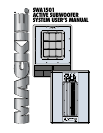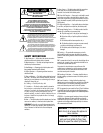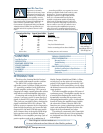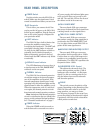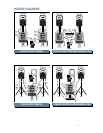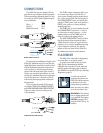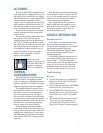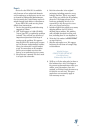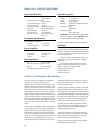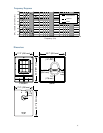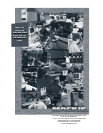
7
AC POWER
Be sure the SWA1501 is plugged into an
outlet that is able to supply the correct volt-
age specified for your model. If the voltage
should drop below 97% of the specified line
voltage, the built-in amplifiers will no
longer be able to supply rated power. (They
will continue to operate down to 80% of
the rated line voltage, but won’t reach full
power, resulting in lower headroom.)
Be sure the electrical service can supply
enough amperage for all the components
connected to it.
We recommend that a stiff (robust) sup-
ply of AC power be used because the
amplifiers place high current demands on
the AC line. The more power that is avail-
able on the line, the louder the speakers will
play and the more peak output power will
be available for cleaner, punchier bass. A
suspected problem of “poor bass perfor-
mance” is often caused by a weak AC
supply to the amplifiers.
Never remove the
ground pin on the power
cord of the SWA1501 or
any other component.
This is very dangerous.
THERMAL
CONSIDERATIONS
The SWA1501 has a powerful 500 watt
amplifier built-in. As amplifiers produce
heat, it is important to dissipate the heat as
quickly as possible. This results in increased
reliability and longevity for the amplifier.
The amplifier module is mounted on a
large heatsink, which is cooled by convec-
tion where cool air is drawn through it’s
fins, carrying the heat away. In order for
this convection cooling to work efficiently,
it is important to provide adequate airspace
behind the loudspeaker. When you position
the SWA1501, we recommend leaving at
least six inches of air space behind it.
In the unlikely event of the amplifier
overheating, a built-in thermal switch will
activate, which mutes the signal. When the
amplifier has cooled down to a safe operat-
ing temperature, the thermal switch resets
itself, and the SWA1501 resumes normal
operation.
If the thermal switch activates frequently,
try turning down the level control a notch
or two on the mixing console (or other sig-
nal source) or on the subwoofer itself to
avoid overheating the amplifiers.
If the temperature in the room is too
high, it could cause the amplifier to over-
heat. In this case, you should try aiming a
fan at the rear panel to move more air
across the heatsink panel.
SERVICE INFORMATION
Warranty Service
If you think your subwoofer has a prob-
lem, please do everything you can to
confirm it before calling for service, includ-
ing reading through the following
Troubleshooting section. Doing so might
save you from being deprived of your
Mackie loudspeaker.
Of all Mackie products returned for ser-
vice (which is hardly any at all), many are
coded “CND” — Could Not Duplicate—
which usually means the problem lay some-
where else in the system. The following
troubleshooting tips may sound obvious,
but here are some things you can check:
Troubleshooting
No power
• Our favorite question: Is it plugged in?
Make sure the AC outlet is live (check
with a tester or lamp).
• Our next favorite question: Is the
POWER
switch on? If not, try turning it on.
• Is the
POWER
LED on the rear panel
glowing green? If not, make sure the AC
outlet is live. If so, refer to “No sound”
next.
• The internal AC line fuse may be blown.
This is not a user serviceable part. If
you suspect the AC line fuse is blown,
please see the “Repair” section on page 9.



